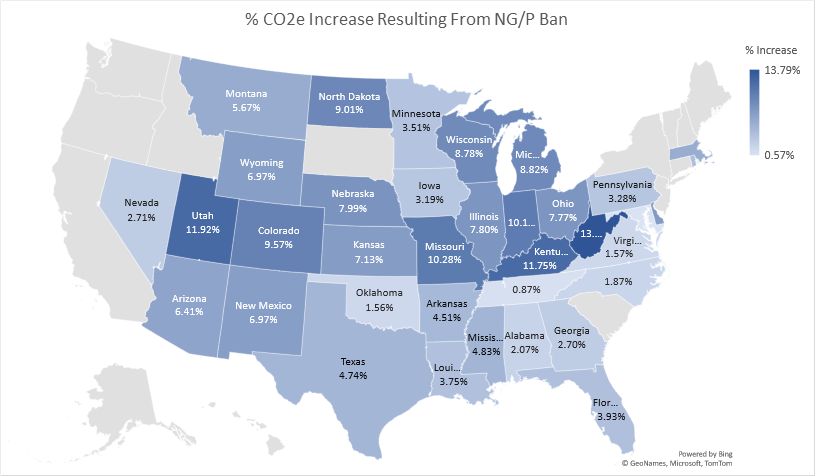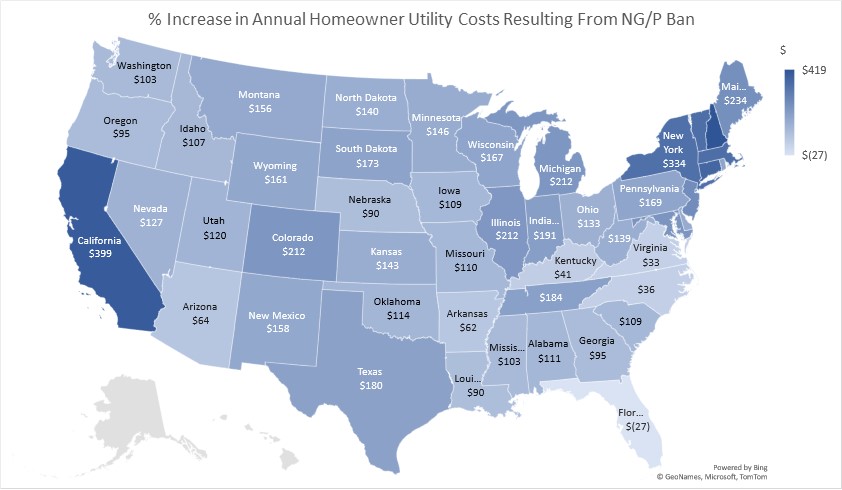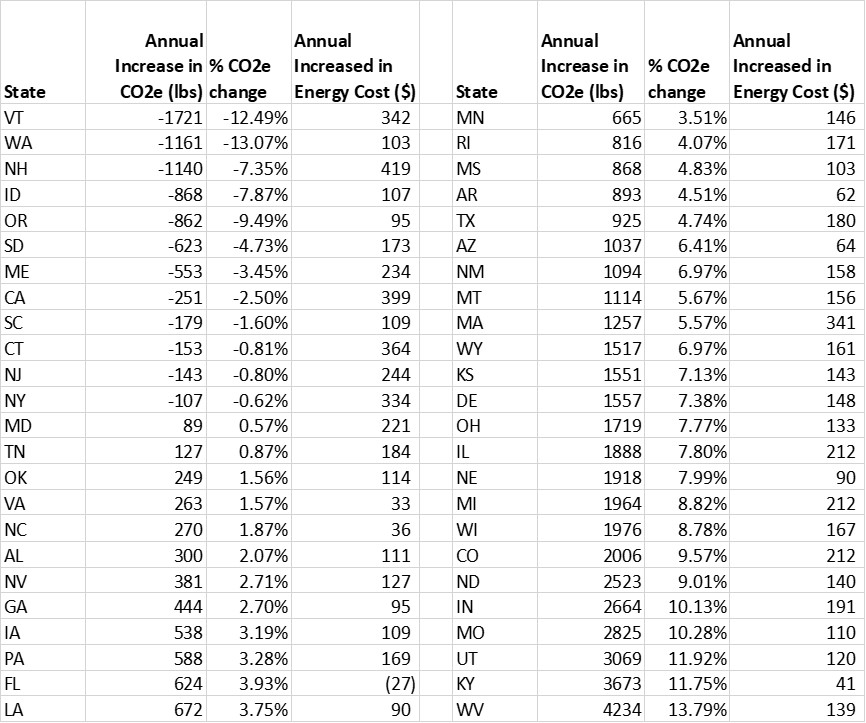| Natural Gas Water Heater Ban: CO2 & Cost Impacts |
Be Careful What You Wish For: Natural Gas/Propane Water Heater Bans Would Increase Both Carbon Emissions and Energy Costs in 36 States
Jerry Jackson, Ph.D., March 16, 2023

 Follow @maisyenergydata
Follow @maisyenergydata
 After reading this note, be sure to take a look at an extended analysis of this topic that goes beyond current electric generation CO2 to include
forecasts of benefits of a NG/P ban in the future based on
historical increases in solar and renewables increases in each state. Click here to see
this analysis result.
After reading this note, be sure to take a look at an extended analysis of this topic that goes beyond current electric generation CO2 to include
forecasts of benefits of a NG/P ban in the future based on
historical increases in solar and renewables increases in each state. Click here to see
this analysis result.
Laws passed in California, New York, and several other states to ban natural gas and propane water heating are often presented as models for the rest of the nation. However, an independent study finds that this policy would increase carbon emissions in 36 states by an average of 6 % and increase household energy cost by $176 per year. Annual cost increases in all 48 states average $200. Study results are based on ZIP-level analysis of individual homeowner data for more than 1 million US dwelling units with natural gas or propane (NG/P) water heaters. These new laws are not retroactive so our analysis results reflect what would happen if new residential construction in each ZIP code reflected patterns of electric versus natural gas choices similar to the current building stock. Study calculations are straight forward. Banning NG/P water heaters will reduce carbon emissions from the combustion of NG/P in the dwelling unit; however, it will result in increased emissions required to generate electricity to support electric water heaters. The increase in electric utility costs minus the avoided NG/P cost is the net utility cost impact. Typical electric tank water and tankless NG/P water heater efficiency characteristics are used in the analysis. Analysis was conducted using a sample of individual households in each of 28,000 ZIP codes. Avoided NG/P water heater carbon emissions are computed based on current homeowner NG/P water heating use. NG/P water heating energy use is converted to electric water heating requirements to calculate increased electricity generation. Generation emissions associated with the increased electric generation are calculated with data provided by the Environmental Protection Agency and the Department of Energy. Energy cost impacts are calculated using 2022 utility average electric prices within each ZIP code and state level NG/P prices. Variations across states in the factors described in the previous paragraph create significant variations in state CO2e emissions and energy costs associated with a NG/P ban. For example, generation emissions factors vary by more than 8 times reflecting variations in generating fuels and technologies and the use of renewables in different parts of the county. It is important to note that the results for each state presented below reflect the aggregation of individual ZIP code areas across the entire state. Emissions and costs for geographic areas within the state (utilities, metro areas, etc.) vary and can be provided. The map above shows the 36 states where banning NG/P water heating would increase CO2 emissions with the percent increase in average homeowner carbon emissions for each state.  Fuel cost differentials make switching from gas to electricity costly with only one state in the analysis reflecting energy bill savings. The average homeowner in Florida, where electricity prices are relative low and NG/P are relative high would experience an annual savings of $27. California leads all states in increased energy costs for the opposite reason: relative low NG/P prices relative to electric prices.
Fuel cost differentials make switching from gas to electricity costly with only one state in the analysis reflecting energy bill savings. The average homeowner in Florida, where electricity prices are relative low and NG/P are relative high would experience an annual savings of $27. California leads all states in increased energy costs for the opposite reason: relative low NG/P prices relative to electric prices.
Note On Heat Pump Water Heaters (HPWH). Heat pump water heaters are not included as an electric option in this analysis because they are and will likely continue to be an unimportant participant in the electric water heating competition. HPWH generate about 40 percent of the emissions of an electric tank water heater; however, there are significant barriers to their market penetration. First, they require installation in spaces of at least 100 square feet with temperatures that range within 40 – 90 degrees F. In addition, HPWH cost is approximately four times that of an electric tank water heater and more than twice that of a tankless NG/P water heater. HPWH lifetimes are about one-quarter that of the electric tank and one-half of a NG/P tankless, so a simple capital cost estimate is 2-4 times that of the options analyzed in this study. One of the greatest disadvantages of HPWH, however, is their long recovery time – that is how much time it takes to recover hot water after a long shower or dishwasher/washer cycle. There is no recovery time for a tankless water heater; electric tank water heaters can typically recover within a 20 to 30 minutes while the HPWH system can take up to two hours. This lack of convenience will likely make HPWH a niche player in the water heater market. The table below shows average homeowner emissions and energy cost impacts from a ban on homeowner NG/P water heaters in each of the 48 continental states.  MAISY (Market and Information System) Residential Utility Customer Databases
MAISY Residential Utility Customer Databases used in this study include dwelling unit, energy use and hourly loads, appliance holdings,
income, and demographics for more than 6.5 million individual households. MAISY data consists of information on a sample of households
within each of more than 28,000 ZIP codes areas. MAISY database information has been used for new technology product design and market
analysis, retail energy marketing, state and federal agency regulatory analysis, utility smart grid cost/benefit analysis and many other
energy-industry applications. Applications range from individual ZIP level to the entire US.
Click Here for additional information.
MAISY (Market and Information System) Residential Utility Customer Databases
MAISY Residential Utility Customer Databases used in this study include dwelling unit, energy use and hourly loads, appliance holdings,
income, and demographics for more than 6.5 million individual households. MAISY data consists of information on a sample of households
within each of more than 28,000 ZIP codes areas. MAISY database information has been used for new technology product design and market
analysis, retail energy marketing, state and federal agency regulatory analysis, utility smart grid cost/benefit analysis and many other
energy-industry applications. Applications range from individual ZIP level to the entire US.
Click Here for additional information.
About the Author Dr. Jerry Jackson is an economist and former Signature Professor at Texas A&M University, Chief of the Applied Research Divisions at Georgia Tech Research Institute and economist at Oak Ridge National Laboratory and the Federal Reserve Bank of Chicago. He counts more than 200 government and private organizations as consulting clients. He is President of Jackson Associates (JA) and the author of MAISY Residential and Commercial Utility Customer Energy Use and Hourly Loads Databases. MAISY data have been used by the US Department of Energy in analysis supporting appliance efficiency standards, by state regulatory agencies from Texas to New York, and by dozens of solar, CHP, battery and other energy equipment manufacturers, utilities, and retail electricity providers. Dr. Jackson has provided testimony in a variety of state and provincial hearings as an expert witness. He holds a Ph.D. in economics from the University of Florida with specialties in econometrics and regional economics. Click Here for a partial list of JA clients. |
Related Topics |